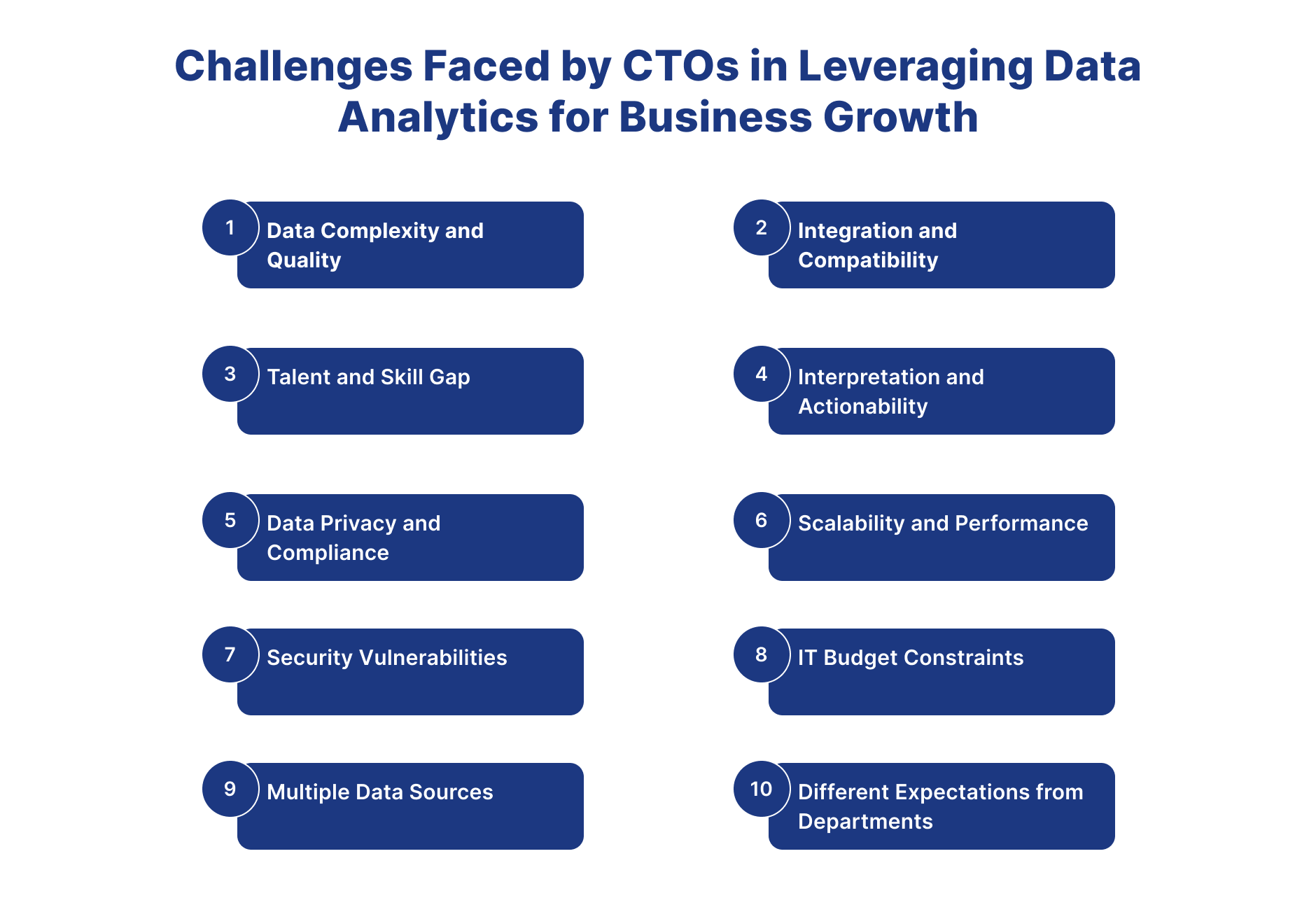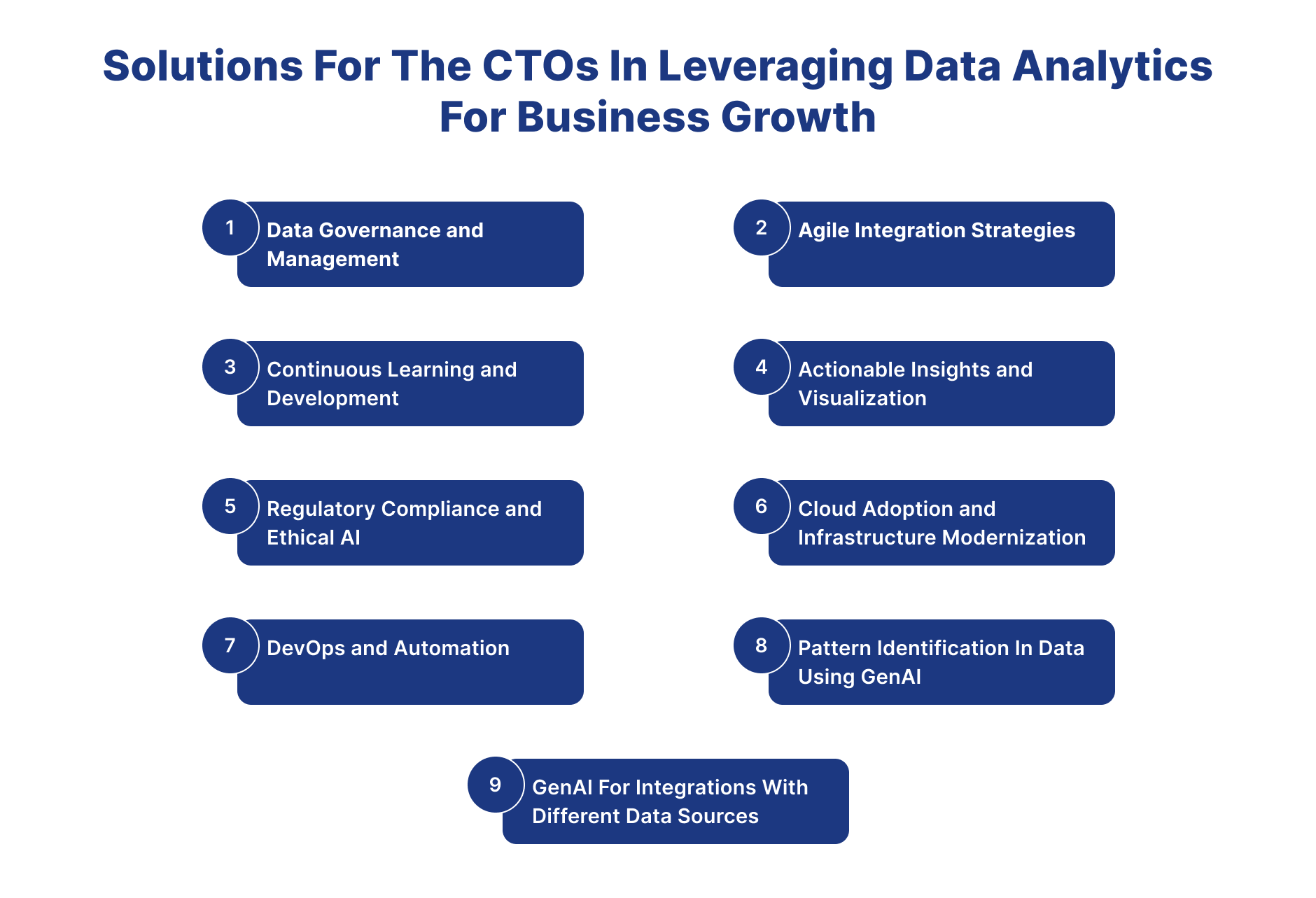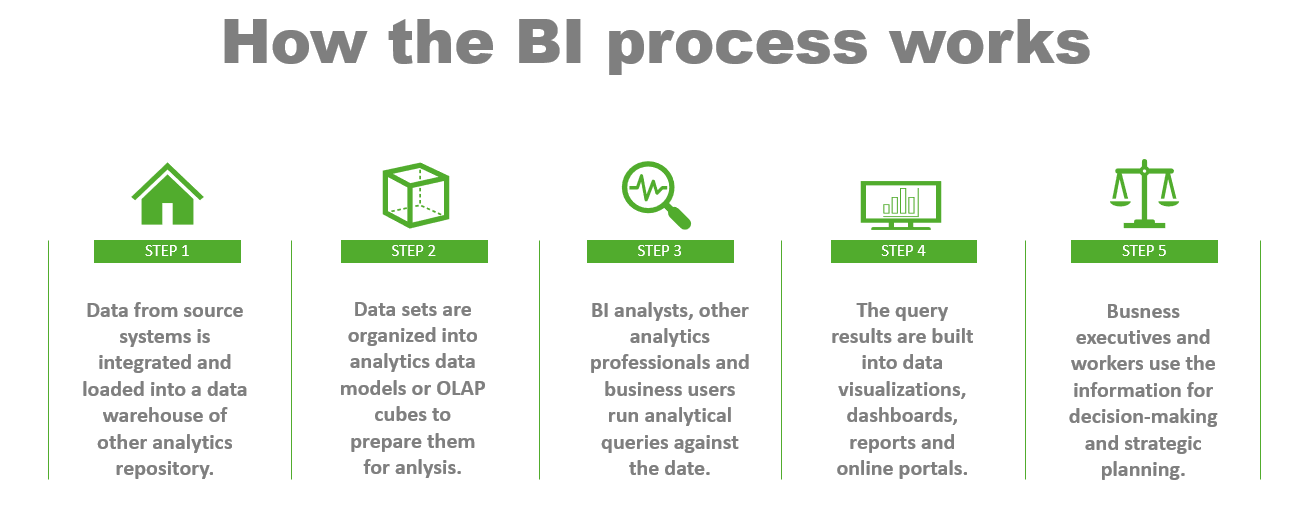AI-Powered Insights: CTO Perspectives on Leveraging Data Analytics for Business Growth
Challenges Faced by CTOs in Leveraging Data Analytics :- 1. Data Complexity and Quality, 2. Integration and Compatibility, 3. Talent and Skill Gap, 4. Interpretation and Actionability
Introduction

- In today's quickly changing technological world, Chief Technology Officers (CTOs) are increasingly important. With the emergence of artificial intelligence (AI), its integration with data analytics, CTOs are at the forefront of using these capabilities for corporate success. However, this voyage has hurdles. Let's look at some of the most typical issues that CTOs experience when using AI to leverage data analytics for business growth and potential solutions to these challenges.
Challenges Faced by CTOs in Leveraging Data Analytics for Business Growth

Data Complexity And Quality
- In today's digital age, organizations get information from various sources, including consumer interactions, transactions, IoT devices, social media, and more. This glut of data is frequently presented in multiple forms, structures, and quality levels. To conduct practical analyses, CTOs must ensure that data is clean, relevant, and correct. Dealing with data complexity with effective data governance and management techniques might result in correct insights and better decision-making. This can challenge CTOs when leveraging data analytics for business growth.
Integration And Compatibility
- Integrating AI-powered analytics solutions into current systems and processes is a crucial problem for CTOs. Legacy systems may employ outdated technology or proprietary formats, making integrating with newer AI platforms difficult. Furthermore, various systems from different departments or acquired through mergers and acquisitions exacerbate integration issues. This can be a challenge for CTOs in leveraging data analytics for business growth.
Talent And Skill Gap
- The fast development of AI and data analytics technology has resulted in a significant talent and skill gap in the workforce. Finding individuals with the essential skills in machine learning, data science, and AI development is challenging for CTOs. Furthermore, maintaining great people in a competitive market adds a complication. Without experienced individuals, organizations struggle to successfully use AI for data analytics, restricting their potential to generate meaningful insights and drive corporate growth. This can be a challenge for CTOs in leveraging data analytics for business growth.
Interpretation And Actionability
- While AI systems excel at processing vast amounts of data and identifying patterns, CTOs still need help comprehending insights and turning them into practical plans. Data analytics outputs can be sophisticated and technical, making it difficult for non-technical stakeholders to comprehend and act on them.
Data Privacy And Compliance
- With the growing emphasis on data privacy standards such as the General Data Protection Regulation (GDPR) and the California Consumer Privacy Act (CCPA), CTOs have difficulty assuring compliance while employing data analytics. Protecting sensitive client information and following legal regulations are critical. However, reconciling the demand for data-driven insights with rigorous privacy requirements necessitates careful planning. This can be a challenge for CTOs in leveraging data analytics for business growth.
Scalability And Performance
- As organizations develop and the volume of data increases dramatically, CTOs have issues with the scalability and performance of AI-powered analytics solutions. It is critical to ensure systems can manage increased data loads and provide timely insights while maintaining performance. Scalability challenges may develop due to hardware infrastructure constraints, poor algorithms, or insufficient resource allocation. This can be a challenge for CTOs in leveraging data analytics for business growth.
Security Vulnerabilities
- With the surge in cyber threats and data breaches, CTOs must address the security flaws associated with AI-powered analytics. AI models and algorithms are vulnerable to adversarial assaults, data poisoning, and model bias, which pose substantial threats to data integrity and confidentiality. Furthermore, storing and processing sensitive data in cloud-based systems raises additional security problems. This can be a challenge for CTOs in leveraging data analytics for business growth.
IT Budget Constraints
- CTOs have a tight IT budget. They have to allocate part of the budget to data analytics cunningly. They also have their existing priorities and new project priorities to manage.
Multiple Data Sources
- Multiple data sources exist, with structured and unstructured data. Moreover, those sources are internal and external. Each source can have a different approach to fetch the data. Data quality can also be a challenge.
Different Expectations From Departments
- CTOs frequently confront the issue of addressing the differing demands of several departments within their organization. This emphasizes the need to tailor solutions to each department's unique requirements.
Solutions For The CTOs In Leveraging Data Analytics For Business Growth

Data Governance and Management
-
Establishing strong data governance frameworks is critical to guaranteeing data quality, integrity, and security. CTOs should develop clear rules and processes for data collection, storage, and utilization throughout the organization. Investing in data management technologies and platforms may help expedite data processing operations and ensure regulatory compliance. CTOs may create the groundwork for successful AI-powered data analytics programs by prioritizing data governance. This can be a solution for leveraging data analytics for business growth.
-
For example, Walmart's data governance practices exemplify effective management of data complexity. With vast consumer data generated daily, Walmart employs stringent data governance frameworks to ensure data accuracy, consistency, and compliance. By investing in advanced analytics platforms and data management tools, Walmart optimizes inventory management, supply chain operations, and customer experiences, driving business growth and competitiveness.
Agile Integration Strategies
- Adopting agile integration methodologies enables CTOs to overcome compatibility issues and speed the adoption of AI-based analytics solutions. Organizations may repeatedly implement and modify AI capabilities within current systems by dividing integration activities into smaller, more manageable components. Collaborating closely with cross-functional teams, including IT, data science, and business divisions, allows CTOs to discover integration requirements and address compatibility concerns early. This can be a solution for leveraging data analytics for business growth.
Continuous Learning And Development
-
Addressing the talent and skill gap necessitates a determined effort to build a culture of continual learning and development inside the organization. CTOs should spend on training programs, workshops, and certifications to help existing staff learn AI and data analytics. Encouraging information sharing and cooperation among team members allows for exchanging best practices and new ideas. Furthermore, collaborating with educational institutions and business organizations can give access to top people and resources for talent acquisition and development efforts. This can be a solution for leveraging data analytics for business growth.
-
For example, Tesla's commitment to continuous learning and development fosters AI and autonomous driving technology innovation. Tesla invests in internal training programs and collaborates with leading research institutions to cultivate AI, machine learning, and robotics talent. By nurturing a lifelong learning and innovation culture, Tesla pioneers advancements in AI-driven automotive technologies, revolutionizing the future of transportation and sustainable energy.
Actionable Insights And Visualization
-
To deliver actionable information, CTOs must prioritize user-friendly visualization tools and interactive dashboards. Organizations may enable business stakeholders to explore data and draw relevant insights by utilizing AI-powered analytics tools with intuitive interfaces. CTOs who work closely with data scientists and analysts may ensure that insights are presented to match strategic goals and allow for informed decision-making. This can be a solution for leveraging data analytics for business growth.
-
For example, Spotify leverages actionable insights and visualization tools to enhance user experiences. With AI-driven analytics, Spotify provides personalized music recommendations and curated playlists tailored to individual preferences. By presenting insights through intuitive interfaces and interactive dashboards, Spotify empowers users to discover new music and engage more deeply with the platform, driving subscriber growth and revenue.
Regulatory Compliance And Ethical AI
-
To ensure regulatory compliance and ethical usage of AI in data analytics, CTOs must take a proactive approach. Transparent data processing processes, gaining informed permission from data subjects, and adopting strong security measures are all critical elements in protecting individuals' privacy rights. CTOs should keep current on developing regulatory frameworks and industry best practices to reduce compliance risks. Furthermore, developing an ethical AI culture inside the organization supports responsible data usage while building consumer and stakeholder confidence. This can be a solution for leveraging data analytics for business growth.
-
Tools such as NeMo-Guardrails can be used to control the response anomalies of the LLM Model. Human feedback on each of the response should be captured to optimize the model further with the human feedbacks.
Cloud Adoption And Infrastructure Modernization
- Embracing cloud computing technologies and modernizing infrastructure can help CTOs overcome scalability and performance concerns. Cloud systems provide elastic scalability, on-demand resources, and powerful analytics capabilities, allowing businesses to handle and analyze enormous amounts of data rapidly. By moving workloads to the cloud and utilizing managed services, CTOs may streamline operations, cut infrastructure costs, and focus on providing value-added services to stakeholders. This can be a solution for leveraging data analytics for business growth.
DevOps And Automation
-
Implementing DevOps principles and automation technologies may boost the agility and efficiency of AI-powered data analytics projects. CTOs may shorten the time it takes to bring AI products to market by automating deployment, testing, and monitoring procedures. DevOps promotes collaboration between the development and operations teams resulting in the smooth integration of AI capabilities into production settings. Furthermore, by employing infrastructure-as-code and continuous integration/continuous deployment (CI/CD) pipelines, CTOs may ensure consistency, stability, and scalability across development and deployment environments. This can be a solution for leveraging data analytics for business growth.
-
For example, Netflix showcases the efficiency gains of DevOps and automation in AI-powered content recommendation systems. By implementing CI/CD pipelines and infrastructure-as-code practices, Netflix accelerates the deployment of AI models and updates to its streaming platform. Through continuous testing and monitoring automation, Netflix ensures the reliability and performance of AI-driven algorithms, delivering personalized content recommendations to millions of subscribers worldwide and driving engagement and retention.
Pattern Identification In Data Using GenAI
-
GenAI-based pattern identification is an important tool for CTOs who want to employ AI in data analytics to build their organizations. CTOs may use generative AI algorithms to my enormous datasets for specific patterns, providing insights into consumer behavior, market trends, and areas where their operations could be more effective. This allows them to make more informed decisions, improve procedures, and increase income.
-
GenAI also empowers various departments to interact with data in a simpler way. Departments can ask questions in human language (instead of coding) and gather their answers from data.
-
Furthermore, GenAI can identify new possibilities and possible hazards early on, assisting CTOs in planning and ensuring the long-term success of their organizations. By leveraging AI to uncover hidden patterns in their data, CTOs may remain ahead of the curve, innovate efficiently, and capitalize on new growth prospects. This can be a solution for leveraging data analytics for business growth.
-
Let's take the insurance industry as an example. An insurance company's Chief Technology Officer (CTO) aims to improve customer retention and identify potential fraud cases more effectively. By leveraging GenAI-based pattern identification, the CTO can analyze diverse datasets, including customer profiles, claims history, and transaction records.
GenAI For Integrations With Different Data Sources
- GenAI can generate code to gather data from different sources. It can also help engineers solve their errors. Tools such as Github Copilot can enhance the productivity of technology teams and help them to solve issues with integrations faster.
Use Standard BI Tools For Data Analytics
-
Business intelligence (BI) is important for using data analytics to help businesses grow. BI tools help companies better understand their data to make smart decisions, improve work, and find new ways to grow. With BI, companies can see their data in easy-to-understand charts and graphs, making it simpler to spot trends and figure out what's going well and what needs fixing. These tools also let businesses monitor important things like sales numbers and customer satisfaction in real-time, so they can fix problems as soon as they arise. BI can predict future trends and help companies stay ahead of the competition.
-
By using data from outside sources, like what's happening in the market and what competitors are doing, BI helps businesses understand what's going on in their industry and find new growth opportunities. Plus, by looking at customer data, companies can figure out what people like and don't like, which helps them make better decisions about how to sell their products or services. Overall, BI helps businesses work smarter, save money, and find new ways to grow and succeed.
-
Companies can analyze the data using business intelligence tools like Tableau, Microsoft Power BI, Sisense, Domo, Zoho Analytics, Looker, etc.
-
Modern BI tools can leverage AI tools and support multiple data sources.
-
Here is the image of how the BI process works

- Source :- QQInfo
MVP approach
- CTOs can develop MVPs instead of investing fully on data analytics. Smaller MVPs targeting specific problem can give confidence to the team and also business stakeholders. Such MVPs does not cost much and can help CTOs invest with proper risk management.
Regular Trainings
- Regular training from industry experts can help internal teams adapt to new skills. Teams can be rewarded and motivated to attend industry events to gain knowledge. External expert skilled resources can also be hired, and such resources can train existing employees. Regular internal meetups and case study sharing sessions can also improve the skill gaps.
Scalable Data Pipelines
- Scalable data ETL pipelines can be built. The pipeline can include various stages of integration, data cleaning/cleansing, storage, monitoring, etc. It can be hosted on a scalable platform such as AWS, Azure, or GCP. The pipeline should be monitored for all system failures. Data observability platforms can also be used.
Conclusion
-
Navigating the world of AI-powered data analytics provides a slew of issues for Chief Technology Officers (CTOs), including dealing with data complexity, personnel shortages, and regulatory compliance. However, these challenges present chances for innovation, expansion, and strategic advancement. CTOs can harness AI's revolutionary potential for driving corporate growth and innovation by adopting a comprehensive strategy that includes strong data governance, rapid integration techniques, continuous learning and development, and proactive security measures.
-
As CTOs manage these difficulties and adopt strategic solutions, they position their companies for success in the digital age. Organizations may gain a competitive advantage and set a course for long-term development and innovation by employing AI-powered insights to drive informed decision-making, optimize operations, and improve customer experiences.
Frequently Asked Questions
What are AI-Powered Insights?
AI-Powered Insights are AI-powered systems that automate and optimize processes using machine learning, natural language processing, and intelligent decision-making capabilities.
How do AI-Powered Insights work?
AI-Powered Insights work by analyzing data, learning patterns, and executing tasks autonomously while integrating with existing systems to streamline operations and improve efficiency.
What are the benefits of using AI-Powered Insights?
The benefits include increased efficiency, reduced operational costs, improved accuracy, 24/7 availability, better customer experience, and data-driven insights for decision-making.
















